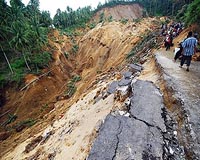| . |  |
. |
Washington DC (SPX) Oct 14, 2009 Scientists at the Carnegie Institution have found a way to monitor the strength of geologic faults deep in the Earth. This finding could prove to be a boon for earthquake prediction by pinpointing those faults that are likely to fail and produce earthquakes. Until now, scientists had no method for detecting changes in fault strength, which is not measureable at the Earth's surface. Paul Silver and Taka'aki Taira of the Carnegie Institution's Department of Terrestrial Magnetism, with Fenglin Niu of Rice University and Robert Nadeau of the University of California, Berkeley, used highly sensitive seismometers to detect subtle changes in earthquake waves that travel through the San Andreas Fault zone near Parkfield, California, over a period of 20 years. The changes in the waves indicate weakening of the fault and correspond to periods of increased rates of small earthquakes along the fault. "Fault strength is a fundamental property of seismic zones," says Taira, now at the University of California, Berkeley. "Earthquakes are caused when a fault fails, either because of the build-up of stress or because of a weakening of the fault. Changes in fault strength are much harder to measure than changes in stress, especially for faults deep in the crust. Our result opens up exciting possibilities for monitoring seismic risk and understanding the causes of earthquakes." The section of the San Andreas Fault near Parkfield, sometimes called the "Earthquake Capital of the World," has been intensively studied by seismologists and is home to a sophisticated array of borehole seismometers called the High-Resolution Seismic Network and other geophysical instruments. Because the area experiences numerous repeated small earthquakes, it is a natural laboratory for studying the physics of earthquakes. Seismograms from small earthquakes revealed that within the fault zone there were areas of fluid-filled fractures. What caught the researchers' attention was that these areas shifted slightly from time to time. The repeating earthquakes also became smaller and more frequent during these intervals - an indication of a weakened fault. "Movement of the fluid in these fractures lubricates the fault zone and thereby weakens the fault," says Niu. "The total displacement of the fluids is only about 10 meters at a depth of about three kilometers, so it takes very sensitive seismometers to detect the changes, such as we have at Parkfield." What caused the fluids to shift? Intriguingly, the researchers noticed that on two occasions the shifts came after the fault zone was disturbed by seismic waves from large, distant earthquakes, such as the 2004 Sumatra-Andaman Earthquake. Pressure from these waves may have been enough to cause the fluids to flow. "So it is possible that the strength of faults and earthquake risk is affected by seismic events on the other side of the world," says Niu. Share This Article With Planet Earth
Related Links Carnegie Institution Bringing Order To A World Of Disasters When the Earth Quakes A world of storm and tempest
 Indonesia calls off rescue efforts in quake-hit city
Indonesia calls off rescue efforts in quake-hit cityPadang, Indonesia (AFP) Oct 5, 2009 Indonesia called off the search for survivors in the quake-hit city of Padang on Monday as officials sought to contain the risk of disease caused by thousands of trapped bodies. ocal officials and foreign specialists who rushed to Indonesia's Sumatra island after Wednesday's devastating 7.6-magnitude earthquake said the aid effort had switched to relief and rebuilding. The United Nation ... read more |
|
| The content herein, unless otherwise known to be public domain, are Copyright 1995-2009 - SpaceDaily. AFP and UPI Wire Stories are copyright Agence France-Presse and United Press International. ESA Portal Reports are copyright European Space Agency. All NASA sourced material is public domain. Additional copyrights may apply in whole or part to other bona fide parties. Advertising does not imply endorsement,agreement or approval of any opinions, statements or information provided by SpaceDaily on any Web page published or hosted by SpaceDaily. Privacy Statement |